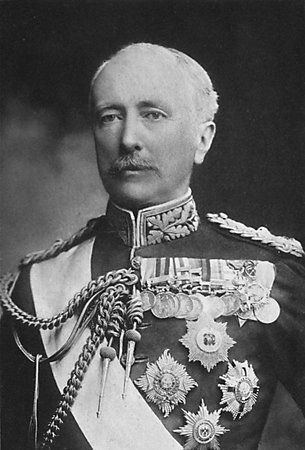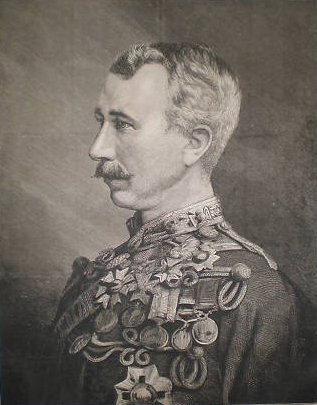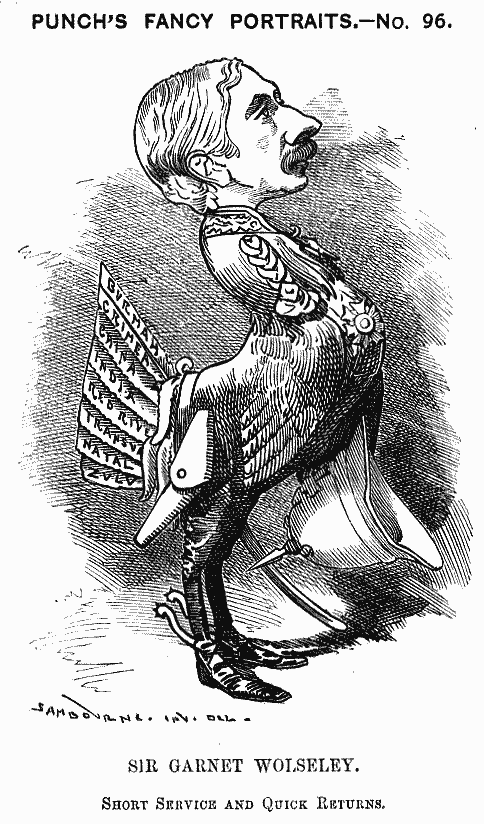An raibh a fhios agat? Did you know?
Field Marshal Garnet Wolseley
Garnet Joseph Wolseley was a Dubliner who would come to prominence serving in the British Army. He was of Anglo-Irish descent his family line stretching back over a thousand years and associated with Staffordshire in England. He would become a celebrated member of the army establishing his reputation for modernisation and efficiency. He built on his achievements through campaigns in Canada, China and Africa, in the Crimean War and in the Indian mutiny apparently. His exploits would cost him dearly suffering a severe leg wound and the loss of an eye. The well-rehearsed line about ‘being mentioned in dispatches’ is perhaps most appropriate in his case. This is a short overview as sources suggest that outside of his military exploits there is not a lot of information pertaining to the man. However, we will endeavour to arrive at a situation whereby 'all is Sir Garnet' as they say.
Introduction
Born in Golden Bridge House Inchicore Dublin on June 4th 1833 he was the son of a retired army officer who was making his way in the world as a shopkeeper. Alas, his father died at an early age leaving his mother to fend for the seven children on a meagre army pension. The young boy had to take up employment at the age of fourteen in a Dublin surveyor’s office in order to support the insufficient family finances. However, it also equipped him with the possibility to enhance his talents for surveying and arithmetic. He also studied algebra, history geography, French and Latin in the evenings. But Wolseley managed to obtain a commission in the army (which was normally purchased) owing to his father’s military career and the perseverance of his mother. She apparently wrote a number of pleading letters to the Duke of Wellington which ultimately had the desired effect. Wolseley himself it appears was burdened by the lack of finance in achieving an acceptable status but decided that by putting himself in the firing line so to speak would propel his drive to prominence. By all accounts this strategy worked. His inclination was to continue the family tradition of military service which stretched back generations apparently. The alternative was the religious pathway. This no doubt would have been due in no small part to his mother’s background coming as she did from a staunchly protestant tradition. According to Comerford (2000) his grandfather, ‘six of his uncles, and four first cousins were clergymen in the Church of Ireland’.
 Another interesting aside to the story of the Wolseleys per se is that Mount Wolseley, now a famed hotel and golf course was formerly the residence of the Wolseley family. They established quarters here in 1725 according to Gilleece (1997). The house was burned to the ground he continues, in the 1798 Rebellion but was rebuilt. Car enthusiasts would be familiar with the Wolseley motor car. Frederick York Wolseley, its founder, was born here according to Gilleece ( 1997). The Wolseleys were bequeathed land in Ireland from the king after the defeat of the Jacobites by King William in 1690 hence their arrival in Carlow in the first instance.
Another interesting aside to the story of the Wolseleys per se is that Mount Wolseley, now a famed hotel and golf course was formerly the residence of the Wolseley family. They established quarters here in 1725 according to Gilleece (1997). The house was burned to the ground he continues, in the 1798 Rebellion but was rebuilt. Car enthusiasts would be familiar with the Wolseley motor car. Frederick York Wolseley, its founder, was born here according to Gilleece ( 1997). The Wolseleys were bequeathed land in Ireland from the king after the defeat of the Jacobites by King William in 1690 hence their arrival in Carlow in the first instance.
As the British Empire expanded taking in more territories around the globe, the potential for conflict increased as a consequence. In order to shore up any holes in the dam as it were, Wolseley saw service in a myriad of different arenas. His first foray into active service saw him embark to India. However, his first campaign if you would was in Burma (Myanmar) were he sustained a leg injury according to Moran (2013). For bravery he was subsequently promoted to the rank of Lieutenant and received the war medal apparently. As a result of the wounds received during the Burma campaign he was invalided home to Dublin on the 16th of May 1853.
The Masons
It was during this period of convalescence that he became a member of the Masons. He entered Lodge no.728 as an apprentice and within several months had attained the position of Master Mason despite his tender years, owing to a special dispensation. Despite the intervention of colonial conflict his connectivity with the Masons would prove to be a lifelong commitment. His regiment would leave Dublin in November 1854 where Welseley was bound for the Crimea. As was his want he again sustained injuries, this time at Sevastopol in June and August of 1855. Here he sustained an extremely serious injury that would cost him his right eye. Again he was awarded with the war medal but with clasp, along with recognition from the French and Turkish military for acts of bravery.
He is credited also with doing away with the practice of being able to buy a commission in the army and for the compilation of the Soldier's Pocketbook for Field Service. While containing the rudimentaries of soldiering etc it also provoked criticism from the military hierarchy in that it suggested a lack of elementary preparation and perhaps outmoded practices. As outlined by Moran (2013) it was Wolseley’s experience during the Crimean War that brought this point home to him. A more professional doctrine had to be embraced. By the time hostilities erupted between the opposing sides during the American Civil War, Wolseley found himself on route to Canada where he would spend nine years. He would be given the opportunity to further engage in his talent for ingenuity.
 Wolseley in Canada
Wolseley in Canada
During the 1860s and 70s in Canada the temperature was rising as a result of attempts by the Fenian Brotherhood to inflict damage to British posts based there. The organisational capacity for such intrusions took place in North America. There was still a residual antipathy towards Britain there due to it's alleged assistance to the Confederate States during the American Civil War. The Fenians were attempting to capture land along the border and to use this as a bargaining chip to force Britain out of Ireland. In 1870 Wolseley found himself engaged in the Red River (Manitoba) expedition to oversee the transfer of land from the Hudson Bay Company to Canada.
This would essentially mean the replacement of Louis Riels provisional government. Riels was leader of the Metis people. These were a combination of Metis, Inuit and First Nations peoples who under the leadership of Riels had twice rebelled against the Canadian government. In order to engage with them Wolseley had to move over eleven hundred men and supplies over six hundred miles of inhospitable terrain in order to reach his destination. This would prove Wolseley's organisational credentials as he achieved this feat without the loss of a single soldier. He was subsequently knighted; Riel's was captured and met the hangman's noose. Despite his daring exploits and his penchant for danger, he still found time to take time out to marry a Louis Erskine on the 4th June 1867 and they subsquently had a daughter .
His exploits did bring him the recognition that he craved and would lead to him serving in campaigns in: Asia, Cyprus, South Africa, and in Egypt where he secured the Suez Canal. Indeed, one of his most famous expeditions was the Nile expedition of 1884. He attempted to come to the aid of General Gordon (of whom Wolseley was a long–time admirer). Gordon was in command of forces at Khartoum in the Sudan. Alas for Gordon, Wolseley arrived two days too late; Khartoum was taken and Gordon killed. Despite this setback no blame was apportioned to Welseley. Returning to his native Dublin he was inaugurated into the ranks of the Knights of St.Patrick on the 28th November 1885. There would be further honours when he was decorated to the role of Viscount and was promoted to the rank of General in 1887. In 1890 he would become commander-in -chief of British forces in Ireland and at this remove lived at the Royal Hospital Kilmainham , according to Comerford (2000).
Conclusion
In attempting to sum up the life of Garnet Joseph Wolseley, it would be fair perhaps to salute his military record and his contribution in attempting to modernise military behaviour. That is not to condone or to make a case for military activity on whatever the rationale. He was by all accounts a brave soldier who sought respectability within the confines of the times and the social strata that he believed he belonged to. His family origins, long established within the halls of conformity and history was to his mind proof of his pedigree. altough this could be argued perhaps. At a period when you could buy your way into rank and establish your credentials via that route, Wolseley had to do it the hard way. From the perspective of his beliefs and the justification of his actions one can surmise that the 'ends justified the means'. He had earned that privilege. He died on the 26th of March 1913 on the French Riviera and lies buried at St.Paul's Cathedral London.
Antóin Ó Lochraigh
Bard & Soloist
Bibliography
Cooke O.A. “WOLSELEY, GARNET JOSEPH, 1st Viscount WOLSELEY,” in Dictionary of Canadian Biography, vol. 14, University of Toronto/Université Laval, 2003–, accessed May 30, 2021.
Comerford.P (2000) An Irishman’s Diary. The Irish Times, Dublin Ireland.
Dodge.T.A. (1904) The Story of a Soldier's Life . Viscount Wolseley. The American Historical Review Vol. 9, No. 4. PP.836-839.Oxford University Press.
Gilleece D. (1997) Location the key to Mount Wolsley's success. The Irish Times, Dublin Ireland.
© Irish Masonic History and Jewels 2014
Moran.S. Great Irish People. Liberties Press, Terenure, Dublin Ireland.
Sambourne. E.L. (1882) Caricature of Wolseley from Punch Magazine. Accessed via Wikipedia 24th.May 2021.
Garnet Wolseley - Biography https://biography.yourdictionary.com › garnet-wolseley
Wikipedia, Portraits of Wolseley ( accessed 12th May and 1st June)

What You Can Expect
A walk through Dublin City in the company of a native Dubliner with the emphasis on history, culture and the great Irish ability to tell a story and to sing a song. In addition, and at no extra cost an actual rendition of a self-penned verse or perhaps a spot of warbling. I'd like to share my love of history with you, after all the past is our present and should be part of our future.
About The Tours
Tours are in English, with Irish translations, where appropriate. I also speak Intermediate level Dutch. Duration: 3 hours approx., with a short break in-between. Tour prices and booking options are available in the booking section.
The contact hours are Monday to Sunday, 09:00 - 20:00 IST.
Special Options
We can also arrange a half-day private tour for a maximum of twelve people. This incorporates a collection of parts of our three Tours combined. Tour duration 4-5 hours approx. A break for refreshments in between. Group of 2: €50 per person, Group of 3: €30 p.p., Group of 4 or more: €25 p.p. Refreshments: €10 approx. (This is an extra). Please contact us for details.
Copyright ©2025 Tailteann Tours
Designed by Aeronstudio™



